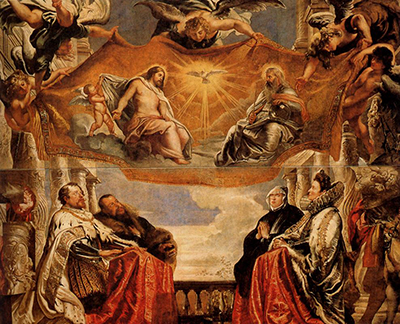This large project is sometimes known under the alternative name of The Gonzaga Family in Adoration of the Holy Trinity. It is a complex series of panel paintings from Rubens which can now be found at the Ducal Palace of Mantua, Italy.
Duke Vincenzo I Gonzaga would commission this piece in the early 17th century, at which point Rubens was working for him as a court painter. This piece was to be the central element of a triptych, with the two sides themed on the Transfiguration and the Baptism of Christ. It is important to remember that Rubens was often restricted by the demands of his patrons, as with most money being in the Church at this time, so his themes would often be religious based. This situation was common for most major artists within both the Renaissance and Baroque eras and it was only a few centuries later that there became a greater freedom within which creative people could focus their talents.
A good number of study drawings have been uncovered over the past centuries which Rubens used in preparation for the work. He created a number of chalk portraits of the key figures within these works whilst also later allowing his assistants to work on the less significant parts of the painting once work on it had commenced. Sadly, much of the completed work was damaged or lost during French occupation of this part of Italy several centuries ago. Whilst this main panel remains intact, several supporting parts have not, and efforts have been made to try to work out how the overall piece originally looked. This is one of the downsides of where art is installed within a specific building with an intended permanency.
No doubt under the direction of the patrons, the painting features Vincenzo I with his wife, Eleonora de' Medici, standing directly opposite the duke's parents, Guglielmo Gonzaga and Eleonore of Austria. Many rulers wanted to see themselves connected to the divine during this period and would instruct the finest artists in Europe to make this combination as real and believable as possible. This, they felt, could help to establish their legacies for many centuries after they had passed as well as morally strengthening their claims to power and wealth. Quite what Rubens though of this, we will never know, but he was very much at the mercy of his patrons during this period and so it was a necessary evil of being financially secure.




